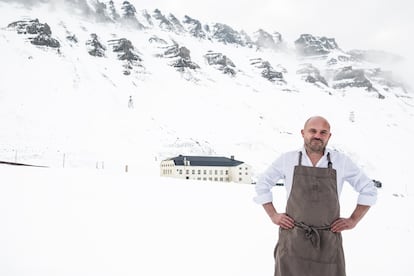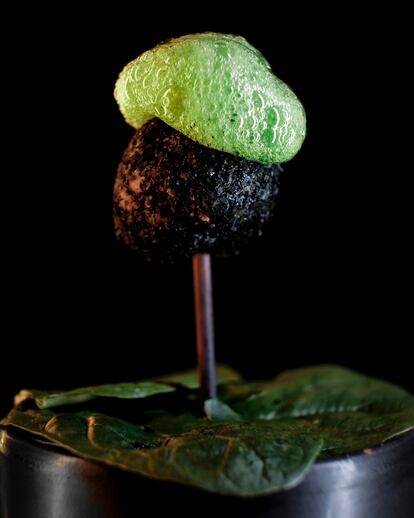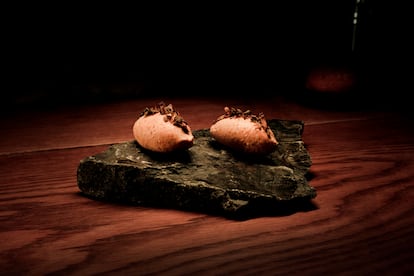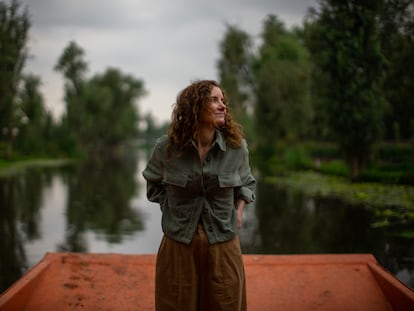Huset, extreme cuisine in the Arctic by a Spanish chef
Alberto Lozano is at the helm of one of the planet’s northernmost restaurants, where he has fed Tom Cruise and uses fossils as tableware

Forty-two-year-old Spanish chef Alberto Lozano always has a good story to tell. In a WhatsApp audio message from Svalbard, the Norwegian archipelago where his restaurant is located, the first thing he says is: “Yesterday I served dinner to Tom Cruise. The Mission Impossible people have been here for two weeks, and it’s crazy. I’ll talk to you as soon as I can.” The next day he makes time to contact us again.
Lozano has been a cook since he was 16 and says he got started in the culinary world because he didn’t study. “I was a loose cannon. My father found me a restaurant in Albacete, Spain, to work in over the summer and to disabuse me of the idea of becoming a chef, but the opposite happened,” explains the chef at the restaurant Huset. Afterward, he went to try his luck in Mallorca and Ibiza and finally settled in London, where he worked at The Epicurean and prepared food for the VIP area of a nightclub in the English capital. Soon after, he decided to return to Spain. “I returned to Albacete to open a mushroom bar, which worked very well, and then I set up a restaurant with the same concept, called Chantarela. With the 2008 [financial] crisis, I closed [my restaurant] and went to the French Alps to work for a Swedish company that has hotels halfway around the world.”
He was hired as the head chef there and stayed for 10 years. “I spent the winters in the Alps and the summers in Corsica. Then I was promoted and became responsible for all things culinary at all the group’s hotels,” he recalls. A year ago, the Norwegian company Hurtigruten contacted him and offered him a job in Svalbard. “Hurtigruten runs all the ferries in the Norwegian fjords; it has several hotels along with Huset,” Svalbard’s oldest building, dating back to the 1950s; Lozano’s restaurant is located in that edifice.
Svalbard is an archipelago in northern Norway, one of the planet’s northernmost places. “There are more polar bears here than people,” Lozano says. “It’s an inhospitable place, but it has very high-quality tourism. And there are incredible things [here] like the seed bank at the end of the world, which attracts many visitors,” he explains. It is currently the high season in Svalbard, and the chef says that a lot of visitors come to make expeditions on snowmobiles. “In the summer, a lot of boats come to see the large cetaceans [marine mammals like whales and dolphins], which gather here because of the Atlantic current,” the chef says.

Extreme conditions
Svalbard’s extreme conditions have led Lozano to creatively make up for the lack of local ingredients, resulting in what he says is zero-kilometer cuisine. “We try to use local proteins. In the winter season, there is no fishing, hunting or anything else. That’s why we keep all the products we can produce in summer and ferment them to have local products in the winter,” he explains. The chef works with local hunters and fishers and picks mushrooms and plants for supplies. “It’s prohibited to do that, but we have a license. Everything here is very regulated and protected. For example, you can’t go off the village roads,” he adds.
Nor can one take just any seed. But one day in the kitchen, Lozano had an epiphany as he was opening some white partridges that the hunters had brought him. “I saw that they had seeds in their craw, and it occurred to me to use them. So, we cured [and] dehydrated them, and I put them on top of a homemade butter. It was exquisite and stayed on the menu,” he says proudly.

Because of local constraints and the need to achieve self-sufficiency, the Huset team is in the process creating a greenhouse inside the building to grow their own plants with seeds from the island and others from outside. They have also started a project for cooking plankton with Beatriz Albiol, a Spanish applied biologist who did her thesis at the University Centre in Svalbard. “We already have some dishes with plankton on the menu, such as dark chocolate bonbons filled with phytoplankton and lavender. But we’d prefer not to have to buy it and instead catch it directly ourselves; I’m organizing [that project] with the local company Green Dog.”
That’s one of 16 dishes on the €150 tasting menu; with a wine pairing, it costs over €300. “We have one of the best wine cellars in Scandinavia, with over a thousand [wines].” And he says that, despite making his living off tourists, his neighbors also fill the restaurant’s tables. “There are 2,500 people living here and we earn good salaries. The locals come here a lot because they love seeing the products cooked in different ways and discovering different spins on beets or celeriac.”

Lozano says he doesn’t miss working with Spanish ingredients. “The lack of product variety pushes me to develop [food] in a different, more astute way. For example, we cook seal, which is the Arctic’s protein. We cure it, pickle it, smoke it and serve it as a fillet on a seaweed waffle with pickled currants and flowers.” Cod is another representative product of his cuisine. “We use all of it. We confit the skin and extract its collagen to make a sauce with the bones and heads infused in seaweed. Nothing is thrown away here,” he says. In fact, in his spare time he looks for fossils to use later in dishes and garnishes charcuterie with reindeer bones. “You have to make the most of what little there is.” However, Huset is never short on Spanish olive oil. “And now I’m going to make a black rice [dish] full of Arctic products, shrimp from here, sea urchins, scallops,” he says excitedly. “But I have to confess that there is one thing I do miss: going out…. and walking into a bar with 25 tapas on the [menu]. Phew... I miss that.
-Have you felt lost here?
-Just the opposite. Loneliness helped me find myself in the kitchen.
Sign up for our weekly newsletter to get more English-language news coverage from EL PAÍS USA Edition
Tu suscripción se está usando en otro dispositivo
¿Quieres añadir otro usuario a tu suscripción?
Si continúas leyendo en este dispositivo, no se podrá leer en el otro.
FlechaTu suscripción se está usando en otro dispositivo y solo puedes acceder a EL PAÍS desde un dispositivo a la vez.
Si quieres compartir tu cuenta, cambia tu suscripción a la modalidad Premium, así podrás añadir otro usuario. Cada uno accederá con su propia cuenta de email, lo que os permitirá personalizar vuestra experiencia en EL PAÍS.
¿Tienes una suscripción de empresa? Accede aquí para contratar más cuentas.
En el caso de no saber quién está usando tu cuenta, te recomendamos cambiar tu contraseña aquí.
Si decides continuar compartiendo tu cuenta, este mensaje se mostrará en tu dispositivo y en el de la otra persona que está usando tu cuenta de forma indefinida, afectando a tu experiencia de lectura. Puedes consultar aquí los términos y condiciones de la suscripción digital.
More information
Últimas noticias
Most viewed
- Sinaloa Cartel war is taking its toll on Los Chapitos
- Oona Chaplin: ‘I told James Cameron that I was living in a treehouse and starting a permaculture project with a friend’
- Reinhard Genzel, Nobel laureate in physics: ‘One-minute videos will never give you the truth’
- Why the price of coffee has skyrocketed: from Brazilian plantations to specialty coffee houses
- Silver prices are going crazy: This is what’s fueling the rally











































